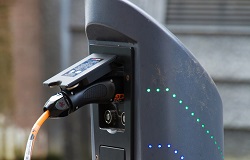The race to integrate new, lightweight materials into mainstream models will intensify, decades-old production processes will need to be transformed and China will grow its lead in electric vehicle (EV) production. Automotive competition in 2017 will be fierce—but will come from unexpected directions. Stefan Issing, Global Industry Director for Automotive at IFS, predicts that these trends will drive the industry in 2017.
EV powers up in the East
In 2017, global consumers will keep racing to reduce their emissions. Sales of alternative fuel cars will double, rising to 20% of total global sales in 2017, compared to 10% in 2015, according to analysts at Horvath. And the bulk of these new sales will be in China, which will continue to corner the market in the mass production of EVs—whilst Europe and the US lag behind. In 2015 China increased sales of EVs from 109,000 to 240,000 units. To put it into perspective: during the same period, UK sales rose from 18,000 to 23,000 units. In July 2016 the market share for EVs in China broke through the 1% barrier, up to 1.1% of all new car sales. It may not sound like much, but 1.1% meant 34,000 new EVs on Chinese roads in July 2016, an 188% increase over June. In 2017 and 18 China will continue to outstrip Europe and the US in EV production and market share.
So how did China achieve this? And what lessons does it offer the US and European OEMs and policy makers? China already set the bar high for reducing fuel consumption in vehicles even back in 2005. At the beginning of its IV-Phase drive to reduce fuel consumption, China, like Europe, included consumer incentives. But, unlike Europe the US or Canada, it also set strict targets for reducing fuel consumption—for individual vehicles as well as fleets. Phase IV, launched January 2016, set a new fleet average target of 5.0 L/100 km for vehicles sold in 2020. And although complex, the system is flexible. Phase IV offers manufacturers a flexible schedule for complying, plus fuel consumption credits for off-cycle fuel saving technologies like start-stop engines, tire pressure monitoring systems, gear shift indicators and efficient A/C systems. This long-term, target-driven approach has been a winner. A 2016 McKinsey report, ”Finding the fast lane: Emerging trends in China’s auto market,” says:
“The majority of EV owners (in China) are keen to buy EVs again. The proportion of consumers who say they are interested in buying an EV has tripled since 2011.”
The lessons for European OEMs and policy makers are clear: a long-term EV strategy that includes more than piecemeal customer incentives is vital. Compare China’s performance to Germany for example, a buyer’s premium incentive resulted in a rise of only 8% (14,013 sold units) of EVs.
 Central to China’s success, too, has been its network of charging stations. It still leaves a lot to be desired. But between 2010 and 2015, the number of charging stations in China grew from 1,122 to 49,000. Factor in privately owned charging stations and stations for buses and logistics vehicles and the total number of stations reached 160,000 in 2015. China aims to build 12,000 centralized charging stations and 4.8 million provincial charging stations by 2020, to meet a forecast demand of 5 million EVs. A robust strategy for charging stations is essential for EV uptake.
Central to China’s success, too, has been its network of charging stations. It still leaves a lot to be desired. But between 2010 and 2015, the number of charging stations in China grew from 1,122 to 49,000. Factor in privately owned charging stations and stations for buses and logistics vehicles and the total number of stations reached 160,000 in 2015. China aims to build 12,000 centralized charging stations and 4.8 million provincial charging stations by 2020, to meet a forecast demand of 5 million EVs. A robust strategy for charging stations is essential for EV uptake.
In 2017, we could well see European manufacturers increase their presence in China around advanced safety technology and crash testing. China is already coming to Europe to test many of their domestic car models. In 2017 and beyond, European manufacturers will help China develop its safety and testing capabilities—as China continues to showcase the benefits of a robust, comprehensive EV strategy.
Less weight, more power—the race for lighter materials
Formula One is a hothouse for the development of ultra-high-speed, ultra-light-weight, tough, crash-resistant materials. In 2017, materials and technologies developed in F1 will keep transitioning into mainstream serial manufacture. But cost will remain an issue. Big-money marketing means that for F1 developer’s, cost is not a priority. For OEM producers, it is. But many are achieving increased quality and cost reduction. 2016 has seen excellent advances in serial vehicles that are safer, lighter and more powerful. In 2017 we’ll see even more. All show the serious competitive edge large-scale manufacturers get when they learn closely from smaller, high-end, innovative manufacturers.
Take 2016’s new Range Rover Evoque. It’s safer, more powerful—and 300 kg lighter than its predecessors. The new Evoque has a powerful, all-aluminium engine that is 20-30 kg lighter than earlier models, delivering fuel economy of up to 4.2 l/100 km and CO2 emissions of 109 g/km. BMW, too, has pioneered new aluminum and carbon fiber materials. Its 2016 i8 model uses more carbon and carbon fiber parts than ever before, combining aluminum, magnesium, high-strength steel and carbon fiber-reinforced plastic (CFRP). The i8 is over 63 kg lighter than earlier models.
But Audi’s new e-tron range brings together all the trends. A high-speed, high-power hybrid, it combines increased battery size and lighter weight. The first plug-in hybrid with a six-cylinder diesel engine, the e-tron consumes 1.7 l / 100 km—less than 50 grams CO2 per km. The lithium-ion battery stores 17.3 kWh of energy, delivering a range of up to 56 km in all-electric mode. Its body structure is developed from a new multi-material design that uses aluminum and high-grade lightweight steel. The whole SUV weighs 1,995 km—about the same as a concert grand piano.
 And new materials are only half the story. New vehicles mean new processes. The growth of EVs and hybrids mean that the many manufacturing processes largely unchanged since Ford’s Model T, are being turned on their head—literally. In EVs and hybrids, the battery is one of the last parts to go in, in the rear of the car, a complete reversal of traditional processes. And take the Audi e-tron: It has a longitudinally mounted engine, constructed using a sophisticated modular matrix system, a far call from the traditional production line. For suppliers and manufacturers, automation and new processes will power their competitive edge. Manufacturing plants like Tesla’s, that rather than having a sequential line have several automated stations, will become the norm. The Tesla plant employs 3,000 people and 180 highly versatile, specialized robots. Process efficiency drives everything.
And new materials are only half the story. New vehicles mean new processes. The growth of EVs and hybrids mean that the many manufacturing processes largely unchanged since Ford’s Model T, are being turned on their head—literally. In EVs and hybrids, the battery is one of the last parts to go in, in the rear of the car, a complete reversal of traditional processes. And take the Audi e-tron: It has a longitudinally mounted engine, constructed using a sophisticated modular matrix system, a far call from the traditional production line. For suppliers and manufacturers, automation and new processes will power their competitive edge. Manufacturing plants like Tesla’s, that rather than having a sequential line have several automated stations, will become the norm. The Tesla plant employs 3,000 people and 180 highly versatile, specialized robots. Process efficiency drives everything.
The life cycle of vehicles reduces year by year, new models arriving thick and fast. In 2017, we will see the backbone of auto manufacturing—the production line—streamline, automate and diversify at an even greater speed as manufacturers and supplier race to produce lighter more powerful vehicles faster. The effects will spread throughout the supply chain. Suppliers too will need to be more innovative, faster and more agile—often transforming their logistics and production processes as smaller, more technologically advanced suppliers start challenging older ones. Speed of development, production and supply will be of the essence. And end-to-end agility and visibility key.
Connected cars power ahead
Brand power isn’t what it used to be. Brand loyalty will dwindle as millennials and up and coming generations of drivers increasingly explore long-term leases and car sharing. For these new consumers, digital capabilities will be a key differentiator. Which services, networks and data can they access? How enabled will their vehicle be? Take again the Range Rover Evoque. It has a centrally-mounted, eight-inch swipe infotainment touchscreen as standard. With smartphone apps built-in. A hands-free tailgate function lets owners automatically open and close the tailgate by waving their foot under the rear bumper. Is this range of services unusual? No. The model still sells primarily on power and weight. The premium range of apps and digital functions is expected as standard.
 Many IT requirements will become mandatory by 2018 too. In the US it will become law, says the National Highway Traffic Safety Administration (NHTSA), to have a rear camera. Every year in the US approximately 200 people are killed and 14,000 injured in back-over accidents, when drivers reverse over someone without noticing them. For most manufacturers, rear cameras are already a priority. By 2017, 80% of all manufactured cars will have one. Back-up cameras are included on around half of all new cars sold in the US today. Wi-Fi hotspots in vehicles too will become the rule, not the exception. In 2017, 20% of car manufacturers will provide WLAN hotspots. In Europe, Audi and BMW are both leading the way. In the US Chrysler, Ford and GM are all powering ahead in hotspot enablement.
Many IT requirements will become mandatory by 2018 too. In the US it will become law, says the National Highway Traffic Safety Administration (NHTSA), to have a rear camera. Every year in the US approximately 200 people are killed and 14,000 injured in back-over accidents, when drivers reverse over someone without noticing them. For most manufacturers, rear cameras are already a priority. By 2017, 80% of all manufactured cars will have one. Back-up cameras are included on around half of all new cars sold in the US today. Wi-Fi hotspots in vehicles too will become the rule, not the exception. In 2017, 20% of car manufacturers will provide WLAN hotspots. In Europe, Audi and BMW are both leading the way. In the US Chrysler, Ford and GM are all powering ahead in hotspot enablement.
Lighter, faster, more powerful and safer—in many ways, the next generation of vehicles is already with us. Constantly changing our understanding of what a car is, what we can do in it and how we power it. For manufacturers and suppliers, it means new directions, new processes, new capabilities and new strategies—and the sooner the better as the road ahead speeds up.
Do you have questions or comments?
We’d love to hear them so please leave us a message below.
Stephanie Reinhardt
Automotive industries are quickly advancing in the last few years. The industries are achieving increased quality and cost reduction. They are at revolutionizing with an embedded system and connected smart hardware and these are for safer, lighter and more powerful. This is appreciating the work. Keep it up.